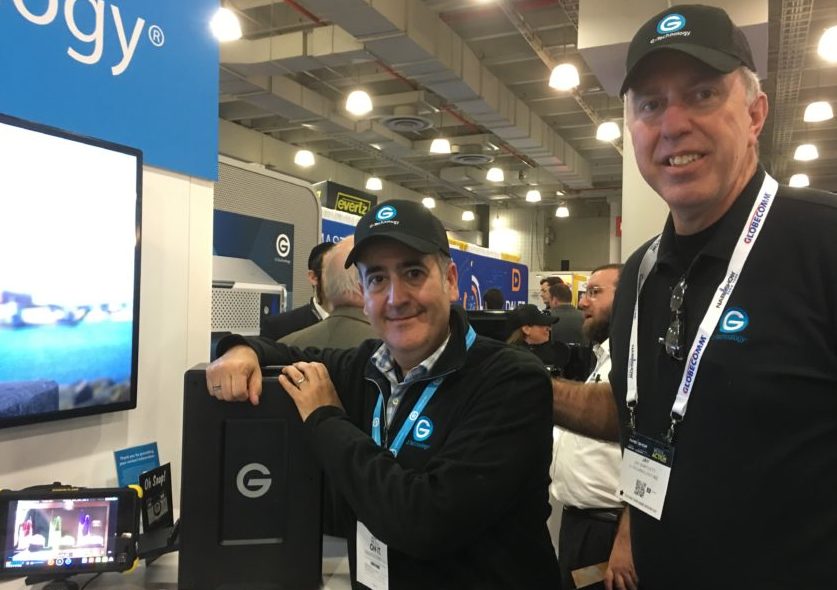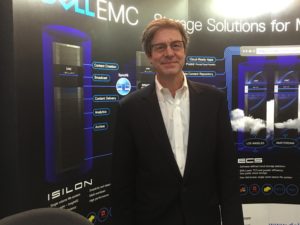M+E Daily

MESA Member Presence Strong at NAB Show New York
Story Highlights
NEW YORK — Several members of the Media & Entertainment Services Alliance (MESA) showcased their latest products and services at NAB Show New York Nov. 9-10 at Jacob Javits Convention Center.
Executives and other representatives of the MESA member companies we interviewed there provided a positive take on the event, saying traffic was good and it provided them with a good way to meet customers on the East Coast and others who can’t always make it to the larger annual NAB Show in Las Vegas. They also gave a thumbs up to the decision by the National Association of Broadcasters to change the name of the N.Y. event to NAB Show New York from Content & Communications World (CCW).
Preliminary registered attendance at NAB Show New York was 15,404 people, up almost 30% from 12,055 in 2015, NAB said. The exhibition featured 362 companies in all, spanning 63,011 square feet of exhibit space, a 15% increase over 2015, it said. NAB Show New York will co-locate with the Audio Engineering Society’s East Coast convention next year, Oct. 18-19.
Aspera
Aspera showcased the latest versions of its high-speed file transfer software and workflow automation solutions for the broadcast and media industries. The entire suite of Aspera products, on-demand offerings and Aspera SDK were displayed, including FASPStream for live event streaming and Aspera Files SaaS.
FASPStream is a new open turnkey video transport solution that enables broadcast-quality live streaming over commodity Internet networks, “allowing users to stream media globally with glitch-free playout and negligible start-up time,” Aspera said in a news release. It’s a solution designed to eliminate expensive and limited satellite-based backhaul, transport and distribution. Demonstrations at NAB Show New York featured a live video streamed from a Royal Caribbean ship, Harmony of the Seas.
 Aspera introduced the first version of FASPStream at the last NAB Show in Las Vegas, Jonathan Solomon, senior sales and systems engineer, told us in an interview at the New York show Nov. 10. “We took a lot of feedback from there, refined it” at IBC in September and now “we’re generating a lot of interest at not just the network level, but even the local level,” he said. As an example of the latter, he said, one customer wanted to use FASPStream as a remote news bureau.
Aspera introduced the first version of FASPStream at the last NAB Show in Las Vegas, Jonathan Solomon, senior sales and systems engineer, told us in an interview at the New York show Nov. 10. “We took a lot of feedback from there, refined it” at IBC in September and now “we’re generating a lot of interest at not just the network level, but even the local level,” he said. As an example of the latter, he said, one customer wanted to use FASPStream as a remote news bureau.
Aspera Files SaaS was launched in late 2015 and provides a solution for sharing large files and data sets directly from cloud and on-premise storage. There are now more than 1,000 organizations on-boarded and over 20 new features and APIs across the platform for third-party collaboration, privacy controls, Enterprise Single Sign-on, Media Preview Carousels for managing large numbers of videos and photos, and instant provisioning of shared folders on any third- party cloud or on-premises storage, the company said. Aspera recently introduced a flexible new pay-as-you-go option in addition to annual pre-committed volume plans that can be purchased directly from the new Aspera Store online. Users can view all transfer usage for Aspera Files and On Demand plans in the new Aspera Usage Portal.
Files SaaS has been “very successful” for Aspera so far, Solomon said. There are “quite a few customers” for it already and there are also “several hundred people” evaluating it, he said, adding: “it’s really taken off better than we expected, and we expected it to take off – we knew there was a market for it.”
Avere Systems
Avere Systems spotlighted its hybrid cloud storage solutions for the enterprise sector, including its NAS Edge filer technology that enables cloud adoption. Avere is used by top visual effects (VFX) studios globally to combat the challenges of working with large digital assets as they seek to produce top-grossing movies. Atomic Fiction, the VFX studio behind movies including “Star Trek Into Darkness” and “Deadpool,” as well as the HBO TV series “Game of Thrones,” uses Avere to help meet aggressive deadlines and deliver VFX to its clients, Avere said in a news release.
 Most recently, Atomic Fiction deployed Avere FXT Edge filers in front of existing NAS arrays to quickly solve pipeline performance issues impacting critical project timelines for the Sony movie “The Walk,” Avere said.
Most recently, Atomic Fiction deployed Avere FXT Edge filers in front of existing NAS arrays to quickly solve pipeline performance issues impacting critical project timelines for the Sony movie “The Walk,” Avere said.
“We started in the world with this thing we call” Network Attached Storage (NAS) optimization, “which was essentially putting an SSD tier in front of other” NAS systems, Jeff Tabor, senior director of product management and marketing, told us in an interview at the show. After focusing on NAS solutions, he said, “what we learned is that people who have NAS today and have lots and lots of files stored in their NAS environment, they want to move to an object-based storage system because it provides better scalability, better efficiency and better manageability of large amounts of unstructured data,” he said. Therefore, Avere started to support both private object and public cloud solutions, he said.
Exhibiting at NAB New York made sense for Avere because media and entertainment is “one of our biggest vertical” target markets, he told us.
Dell EMC
Dell EMC spotlighted storage solutions including its Isilon scale-out NAS and Elastic Cloud Storage (ECS). The company was exhibiting at the New York show for the first time since the recent merger of Dell and EMC Corp., Tom Burns, CTO of media and entertainment, pointed out.
 “What you get” from the merger is, “instead of just selling enterprise storage, now we can configure servers and storage together, and that leads to virtualization and converged infrastructure,” he said.
“What you get” from the merger is, “instead of just selling enterprise storage, now we can configure servers and storage together, and that leads to virtualization and converged infrastructure,” he said.
“What we’re seeing is that broadcast” independent software vendors (ISVs) “are virtualizing their applications on our converged infrastructure, and that makes it really easy” for a company with many TV stations running the same converged infrastructure to “move workloads back and forth,” he said. Such a company can “take a whole station off-air, run it all out of the same converged infrastructure that the other stations are running, do maintenance,” and then go right back on the air,” he said, calling it “seamless migration of workloads through time and space.”
G-Technology
G-Technology demonstrated several of its latest storage solutions products for audio/video production at the show. They included the ev Series Reader Atomos Master Caddy Edition, the Atomos Master Caddy 4K by G-Technology and the Atomos Master Caddy HD by G-Technology. The company is also offering a new G-Technology ev Series Reader CFast 2.0 Edition, supporting fast CFast media cards for 4K video workflows for people using professional cameras, as well as the new rugged and lightweight 2-TB G-DRIVE ev RaW with up to 100 percent more capacity for creative professionals on the go.
 G-Technology is making the Master Caddy storage solutions for Atomos as part of an exclusive deal, Bobby Lombardi, head of market development at G-Technology, told us in an interview at the show. Trying to record in 4K and HDR at 60 frames per second is a challenge and requires “you buy some decent media,” and the Master Caddy 4K solves the issue. It features G-Technology’s SSD media inside and follows the purchase of SanDisk by G-Technology parent Western Digital earlier this year, he said, adding “this media is the first of our products that now use the SanDisk Pro X400 media inside.”
G-Technology is making the Master Caddy storage solutions for Atomos as part of an exclusive deal, Bobby Lombardi, head of market development at G-Technology, told us in an interview at the show. Trying to record in 4K and HDR at 60 frames per second is a challenge and requires “you buy some decent media,” and the Master Caddy 4K solves the issue. It features G-Technology’s SSD media inside and follows the purchase of SanDisk by G-Technology parent Western Digital earlier this year, he said, adding “this media is the first of our products that now use the SanDisk Pro X400 media inside.”
IBM Cloud Video
IBM Cloud Video showcased a series of new Watson integrations to bring cognitive capabilities to end-to-end video solutions, including Live Event Analysis, Video Scene Detection and Audience Insights.
Tata Communications
Tata Communications demonstrated its new automated Cloud Master Control solution that allows people to distribute their localized content to more markets.
 With it, customers that have content and metadata in their own private clouds can use and re-use it at a very low cost, adding local content to glean more revenue from whatever markets they tap, according to the company.
With it, customers that have content and metadata in their own private clouds can use and re-use it at a very low cost, adding local content to glean more revenue from whatever markets they tap, according to the company.
“We are in the process of delivering that now to our first customer,” Rob Goldfarb, senior solutions architect for GES sales engineering (media), told us.
Verizon Digital Media Solutions
Verizon Digital Media Services earlier this year bought Volicon, a company that provides video capture and monitoring tools for TV broadcasters. Verizon, at the show, spotlighted how the Volicon-developed service is enhancing Verizon’s ecosystem. That ecosystem includes the Uplynk Video Streaming Service and the EdgeCast content delivery network, Keith DesRosiers, director of solutions engineering at Volicon, pointed out.
 The Volicon Media Intelligence service was recently enhanced with the integration of Verizon’s Slicer application, an essential software element of the Uplynk Video Streaming service.
The Volicon Media Intelligence service was recently enhanced with the integration of Verizon’s Slicer application, an essential software element of the Uplynk Video Streaming service.
This integration allows users of the Volicon service to launch over-the-top (OTT) offerings quickly and efficiently by leveraging their existing Volicon hardware infrastructure. The Volicon Media Intelligence service, deployed at over 1,000 broadcast locations worldwide, records broadcast content across interfaces including SDI (serial digital interface), TS (a digital container format for transmission), and analog for purposes of monitoring, compliance and review. The Uplynk Video Streaming service offers a comprehensive solution for broadcasters to stream linear channels, live events and on-demand clips to online viewers on an array of mobile phones, tablets, web browsers and streaming devices.









